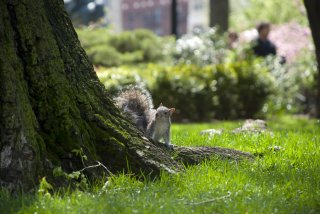Benefits of Trees and Vegetation
Trees and vegetation in urban environments cool local heat island effects and bring other benefits.
How Trees and Vegetation Reduce Heat
Trees and vegetation (e.g., bushes, shrubs, tall grasses) lower surface and air temperatures by providing shade and cooling through evapotranspiration. Evapotranspiration is a process in which trees and vegetation absorb water through their roots and evaporate it through their leaves. Essentially, evapotranspiration cools the air by using heat from the air to evaporate water. This cooling also occurs from the surrounding soil and when trees and vegetation catch rainfall on their leaves. One review of 308 studies found that, on average, urban forests were 3.0° F (1.6°C) cooler than urban non-green areas.1Co-Benefits of Trees
Trees, vegetation, and other heat island reduction strategies offer a number of co-benefits, as shown in the figure and described below.
Reduced energy use and lower greenhouse gas emissions. Trees and vegetation that directly shade buildings decrease demand for air conditioning. Green infrastructure including urban parks and forestry can reduce and the energy demand of nearby buildings by 10 percent.2 This in turn reduces emissions of greenhouse gases from fossil fuel energy production, helping to mitigate climate change. Trees also directly store and sequester carbon dioxide from the air through the photosynthesis process.

Improved air quality. Airborne pollutants may deposit on tree leaves, directly removing them from the air. These include particulate matter (PM), nitrogen oxides (NOX), sulfur dioxide (SO2), carbon monoxide (CO), and ground-level ozone (O3). Roadside vegetation that is tall and dense can lessen downwind pollutants by approximately 30%.3 Trees indirectly improve air quality by lowering energy use and the associated pollution from fossil fuel power generation.
Enhanced stormwater management and water quality. Trees and vegetation support water quality in three ways. First, they absorb excess rainfall, thus reducing the amount of water that runs off roofs and streets into local water bodies. Urban trees can reduce stormwater runoff by absorbing 15 to 27% of annual rainfall.4 Second, trees and vegetation filter fertilizers, pesticides, animal waste, and other pollutants, which readily runoff paved surfaces during storms. Third, trees provide shade that can cool water runoff and prevent water temperature shocks to aquatic life.
Improved quality of life. Studies show that human interaction with nature reduces high heart rate and blood pressure, and increases immune system function.5 Increasing tree cover also reduces heat illnesses such as heat stroke.6 Similarly, tree cover is linked to fewer heat-related deaths in urban areas. One analysis estimates that a 10% increase in tree cover would result in approximately 50 fewer deaths per year in Salt Lake City, Utah and 3,800 fewer deaths in New York City, New York.7 Additionally, trees and vegetation can act as a physical barrier to reduce noise and light pollution.
Wildlife habitat. Trees and vegetation provide essential habitat and food for many species, including pollinating insects, migratory birds, and small mammals (e.g., bats, squirrels).

Improved equity. Data show that certain populations experience disproportionate harm due to extreme heat, including minority populations and those with low incomes. Research shows how these relationships are also linked to vegetation. One study found that areas within cities with less vegetation have hotter temperatures, are home to more residents with lower incomes, and have more residents that are Hispanic or Black.8 Learn more on the Heat Islands and Equity webpage.
Other co-benefits. There are numerous other co-benefits associated with trees and vegetation including increased safety, higher property values, and increased climate change resilience.9
More Information and Resources
More details are available in Chapter Two of EPA’s Reducing Urban Heat Islands: Compendium of Strategies, which covers the following topics:
- How trees and vegetation reduce temperatures
- The benefits and costs associated with trees and vegetation
- Other factors to consider when using trees and vegetation
- Urban forestry initiatives
- Tree and vegetation tools and resources
References
- Knight, T., S. Price, D. Bowler, et al. 2021. How effective is 'greening' of urban areas in reducing human exposure to ground-level ozone concentrations, UV exposure and the 'urban heat island effect'? An updated systematic review. Environmental Evidence 10, 12.
- Zhu, S., F. Causone, N. Gao, Y. Ye, X. Zhou, and X. Shi. 2023. Numerical simulation to assess the impact of urban green infrastructure on building energy use: A review. Building and Environment 228:109832.
- Deshmukh, P., V. Isakov, A. Venkatram, B. Yang, K.M. Zhang, R. Logan, R., and R. Baldauf. 2019. The effects of roadside vegetation characteristics on local, near-road air quality. Air Quality, Atmosphere & Health 12, 259–270.
- Ferrini, F., A. Fini, J. Mori, and A. Gori. 2020. Role of Vegetation as a Mitigating Factor in the Urban Context. Sustainability 12(10): 4247.
- Cobreros, C., N. Medoza-Ruvalcaba, M. Flores-Garcia, and R. Roggema. 2023. Improving Psychological Well-Being in Urban University Districts through Biophilic Design: Two Cases in Mexico Sustainability 15(7):5703.
- Heidari, H., A. Mohammadbeigi, S. Khazaei, A. Soltanzadeh, A. Asgarian, and A. Saghafipour. 2020. The effects of climatic and environmental factors on heat-related illnesses: A systematic review from 2000 to 2020. Urban Climate 34:100720.
- Sinha, P., R.C. Coville, S. Hirabayashi, B. Lim, T.A. Endreny, and D.J. Nowak. 2022. Variation in estimates of heat-related mortality reduction due to tree cover in U.S. cities. Journal of Environmental Management 301(1).
- Wilson, B. 2020. Urban Heat Management and the Legacy of Redlining. Journal of the American Planning Association 86(4): 443-457.
- Arbor Day Foundation. 2023. Tree Facts.


